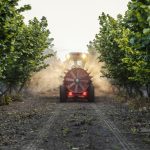Farm chemicals create unstoppable superbugs, researchers warn
 (NaturalHealth365) Every time you turn on a tap, you might be exposing yourself to an invisible threat that’s reshaping the microbial world in dangerous ways. A comprehensive review published in Environmental Geochemistry and Health has revealed a concerning link between pesticide contamination and the emergence of antibiotic-resistant “superbugs.”
(NaturalHealth365) Every time you turn on a tap, you might be exposing yourself to an invisible threat that’s reshaping the microbial world in dangerous ways. A comprehensive review published in Environmental Geochemistry and Health has revealed a concerning link between pesticide contamination and the emergence of antibiotic-resistant “superbugs.”
The numbers are devastating: about 5 million people died in 2019 from infections caused by antibiotic-resistant microbes. By 2050, according to World Bank estimates, antibiotic resistance could add $1 trillion to global healthcare costs while subtracting $3.4 trillion from annual global gross domestic product.
Global water systems under attack
The presence of both pesticides and antibiotics in water bodies, especially those receiving agricultural runoff and hospital waste, multiplies the risk of antimicrobial resistance. As the research notes, “the waters of the world are largely connected, from snow zones to oceans, so that in many cases what enters one body of water affects everything downstream.”
This global connectivity means that contamination anywhere becomes everyone’s problem. Resistant bacteria developed in one region can spread through interconnected water systems, international shipping, and global food trade.
How pesticides train bacteria to survive antibiotics
Dr. Vishwajeet Sonkar and his research team documented how pesticides create perfect conditions for antimicrobial resistance. When agricultural runoff carries pesticides into waterways, these chemicals act as selective evolutionary pressures that favor the toughest microorganisms.
Antibiotic resistance is a form of natural selection in action, where survivors reproduce to create populations that are resistant to antibiotics. As researchers explain, “microbial resistance is accelerating as the world becomes more saturated with chemicals that trigger natural selection.”
Pesticides often function as antibiotics, whether intentionally or not, inadvertently training bacteria to survive antibiotic treatments.
The microbial defense arsenal
Bacteria have developed sophisticated resistance mechanisms that pesticides strengthen:
Efflux pumps actively expel toxic substances from bacterial cells. Horizontal gene transfer enables bacteria to share resistance genes through plasmids – packets that can alter membrane permeability, dismantle antibiotics, or change chemical targets.
Biofilm formation creates protective communities where bacteria can be a thousand times more resistant to antibiotics than free-living bacteria. Biofilms harbor “persister cells” that remain dormant during antibiotic treatment, then revive to regenerate resistant populations.
In areas where both pesticides and antibiotics are present, the evolution of resistance accelerates dramatically.
Specific chemical culprits
Research has identified specific pesticides that promote resistance to certain antibiotics. Glyphosate, 2,4-D, and dicamba contribute to the development of bacterial resistance to tetracycline and ampicillin. Chlorpyrifos increases multidrug-resistant plasmid transfers. The fungicide azoxystrobin causes Pseudomonas aeruginosa to bolster its defense systems.
This demonstrates direct, measurable connections between the use of agricultural chemicals and failures in life-saving medication.
Regulatory Failure
Current policies are insufficient. Beyond Pesticides argues that “we must stop broadcasting pesticides in the environment. The crisis in antibiotic resistance, which creates a threat of another pandemic, is ignored in the registration of pesticides.”
They recommend the EPA not register pesticides unless proven not to contribute to antibiotic resistance – a fundamental shift from current approval processes.
Take control: Your defense against chemical water contamination
Don’t wait for government agencies to solve this crisis – you can protect your family starting today.
Transform your tap into a health asset. Standard municipal water treatment wasn’t designed for today’s chemical cocktails. Invest in advanced filtration that removes both pesticides and pharmaceutical residues. Since biofilms carrying resistant bacteria can be found in agricultural runoff and sewage systems, your water deserves advanced protection.
Turn your kitchen into a pharmacy. Nature provides powerful weapons against resistant pathogens that Big Pharma can’t replicate. Load your plate with organic garlic, oregano, and medicinal mushrooms – foods containing antimicrobial compounds that work even when antibiotics fail. Fermented foods like kefir, sauerkraut, and kimchi flood your gut with beneficial bacteria that crowd out dangerous pathogens.
Become a chemical detective. Every non-organic bite potentially adds to your toxic burden. When your liver is overwhelmed processing pesticides, it can’t protect you from resistant bacteria. Choose organic produce strategically, especially for the “Dirty Dozen” foods that have the highest levels of contamination. Support your liver with milk thistle and N-acetylcysteine, giving your natural detox systems the backup they need in today’s chemical world.
Detoxification solution
This research reveals how daily exposure to environmental toxins can create cumulative health risks that extend beyond the effects of individual chemicals. Antibiotic-resistant bacteria in contaminated water are one consequence of living in a chemically saturated environment.
Most people remain unaware that their water sources may contain chemical combinations that compromise their health and contribute to global antibiotic resistance.
Comprehensive detoxification strategies become essential for personal health and reducing environmental chemical burdens that drive the evolution of antibiotic resistance.
Jonathan Landsman’s Whole Body Detox Summit features 27 leading scientists and doctors revealing breakthrough strategies for removing environmental toxins, including pesticides and pharmaceutical residues. Discover advanced protocols that could help protect your family from contaminated water while supporting your body’s natural ability to process and eliminate dangerous chemical combinations.
Sources for this article include:



